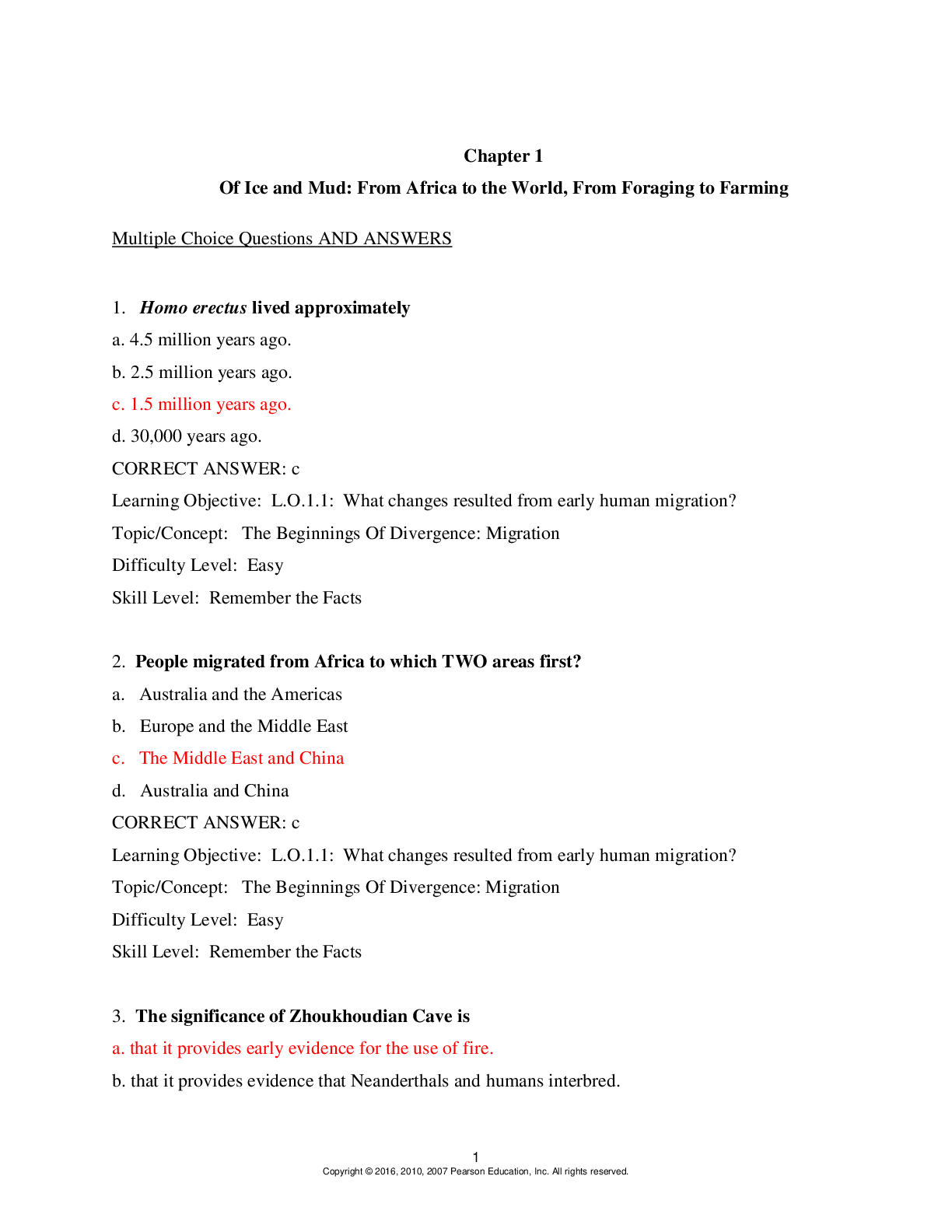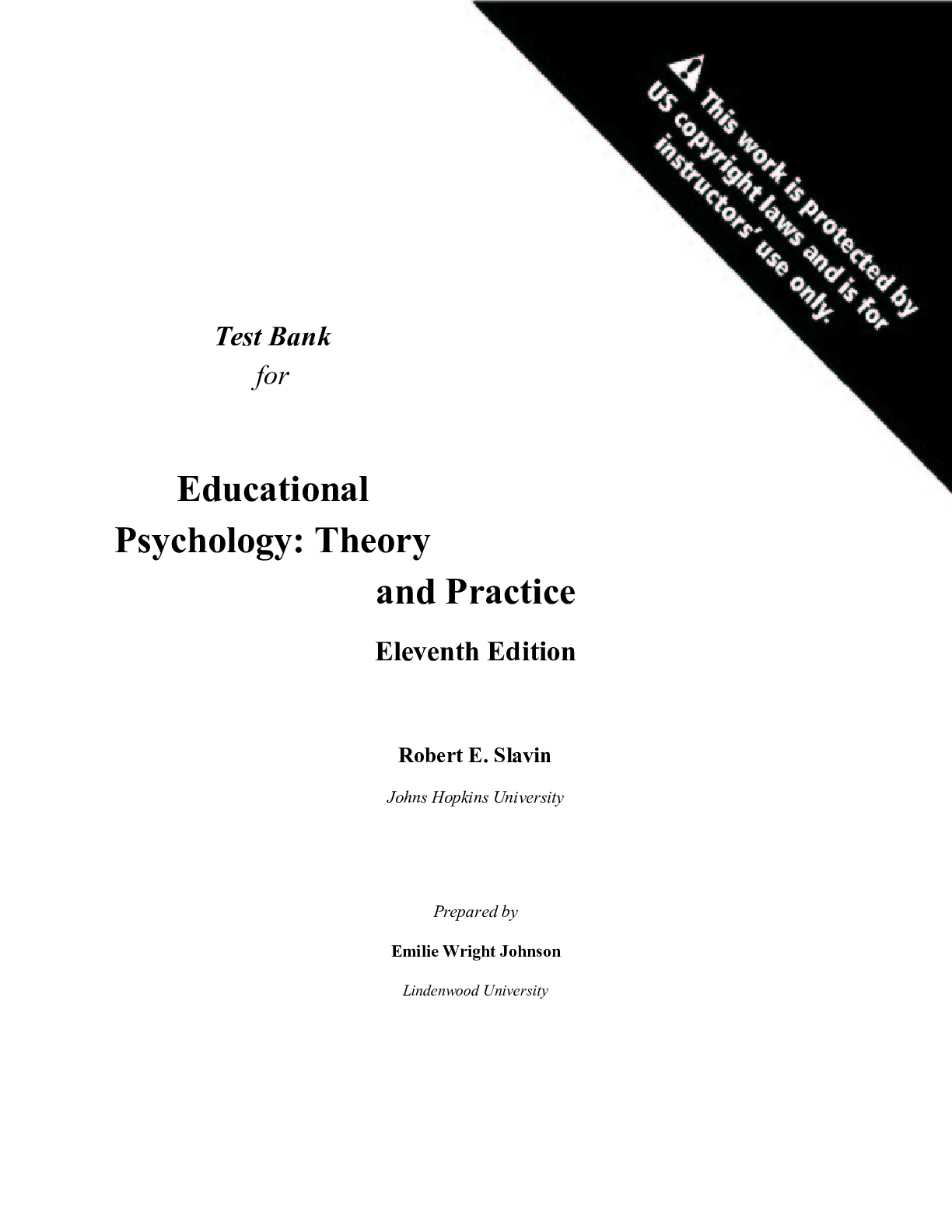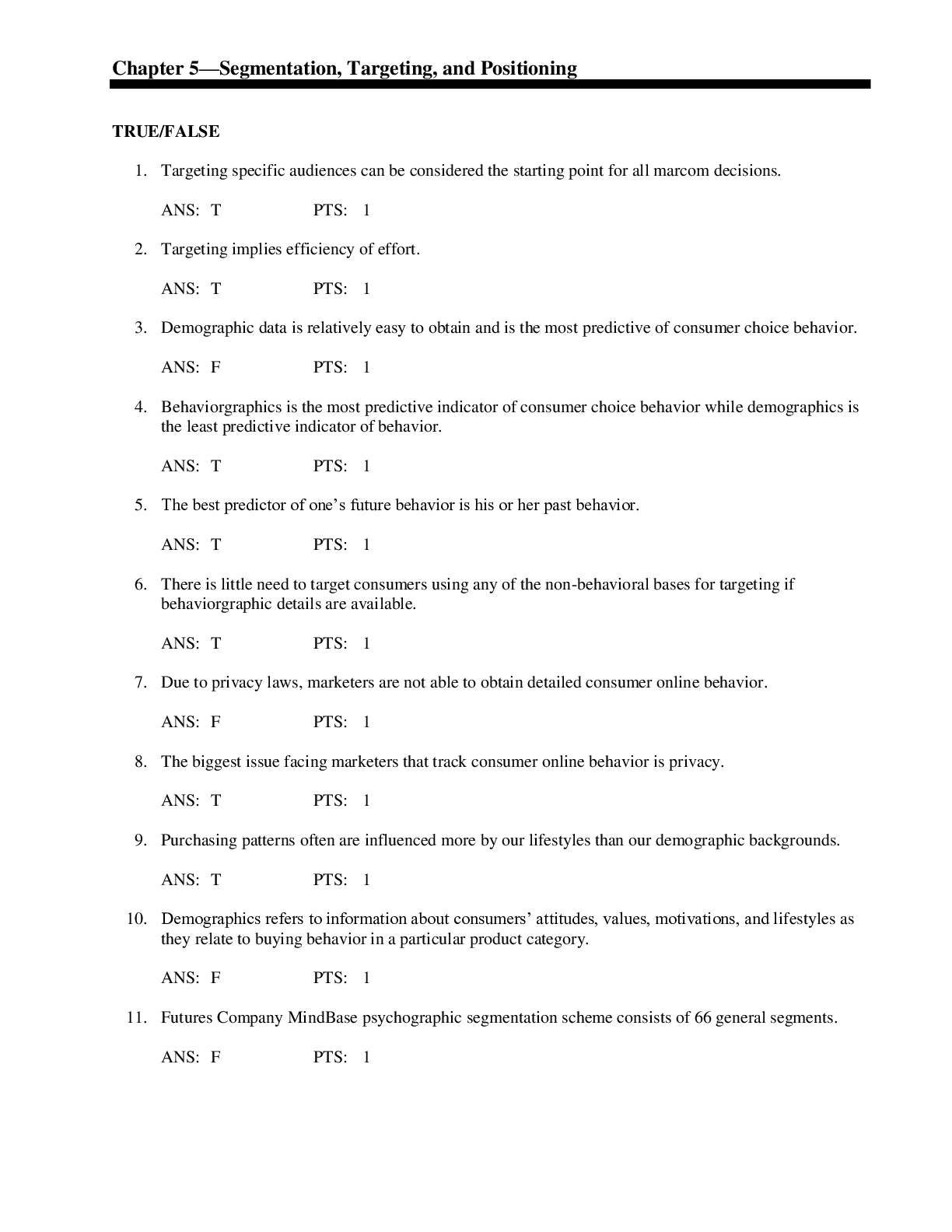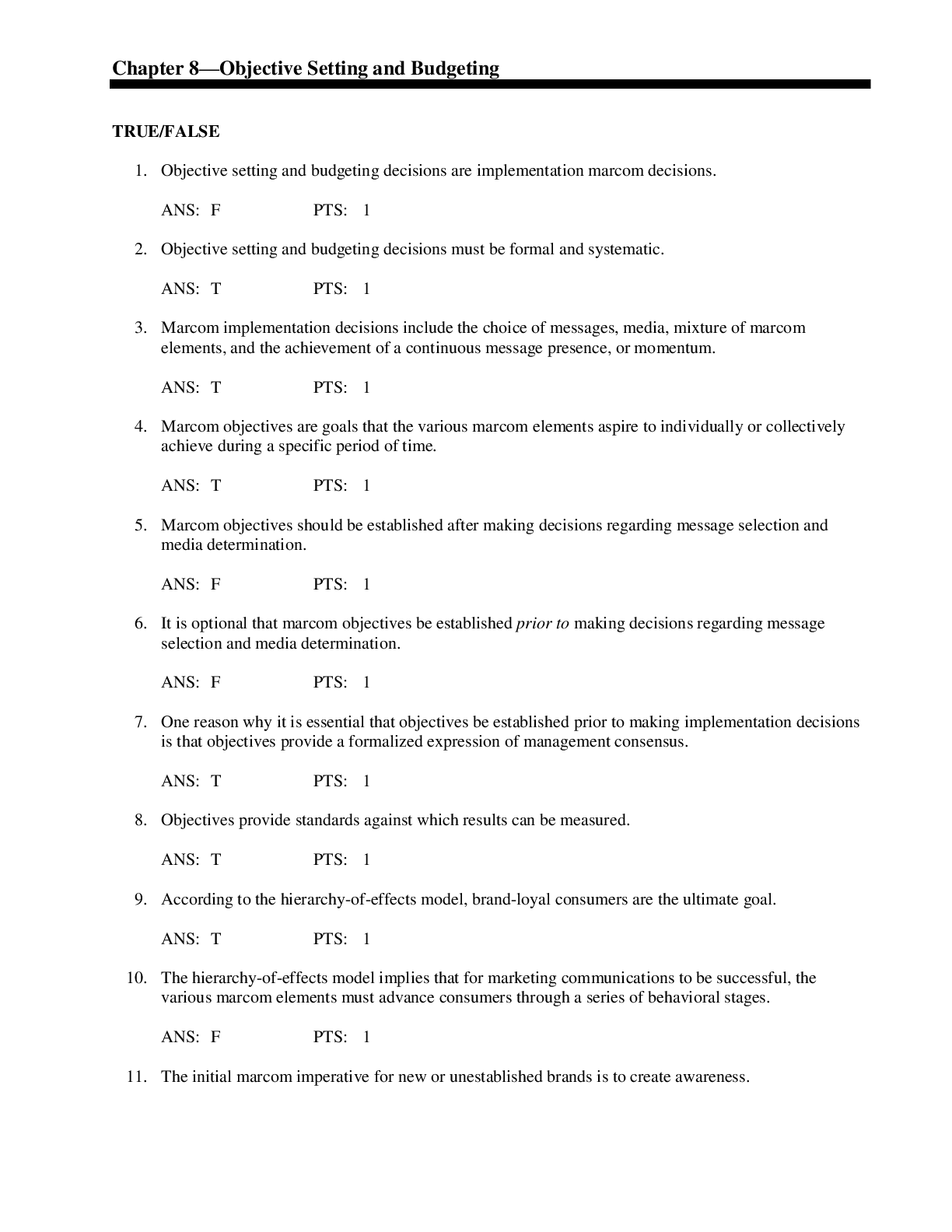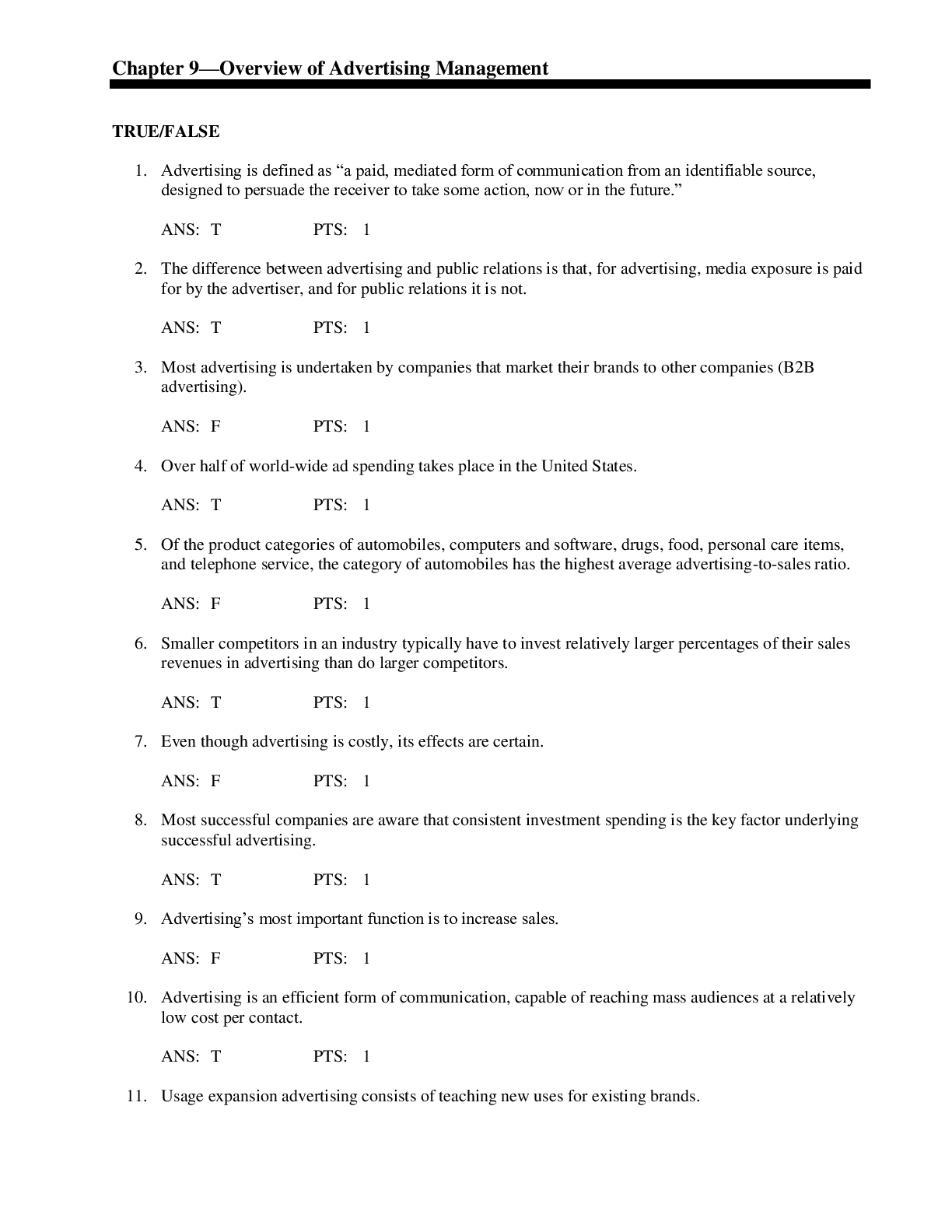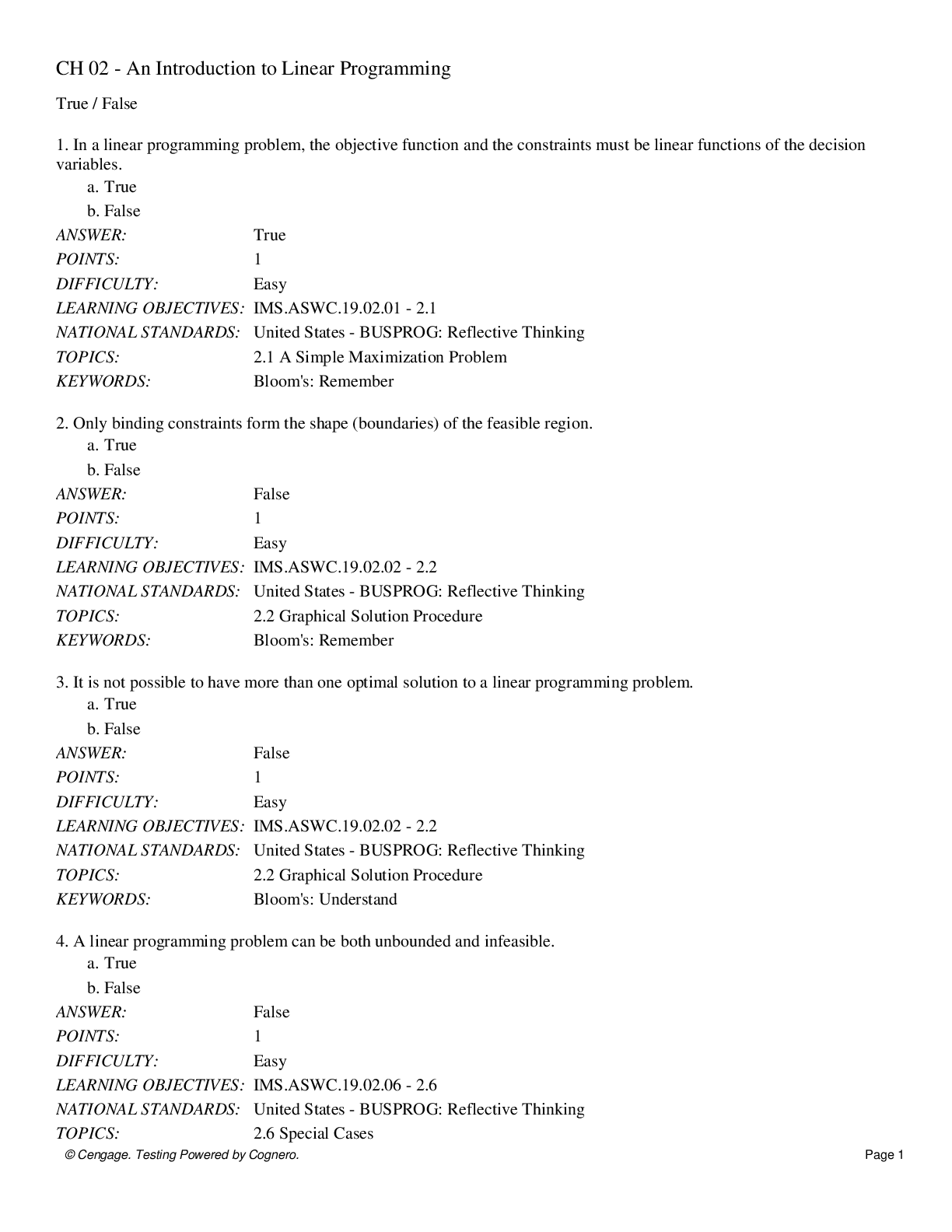Social Sciences > QUESTIONS & ANSWERS > ACCS Review Part 2 Respiratory Questions and Answers 100% Pass (All)
ACCS Review Part 2 Respiratory Questions and Answers 100% Pass
Document Content and Description Below
ACCS Review Part 2 Respiratory Questions and Answers 100% Pass ARDS Classification , Berlin Criteria ✔✔Mild ARDS : P/F ratio < 300, Moderate ARDS: P/F ratio < 200, Severe ARDS: P/F ratio < 100... NSTEMI , Non-ST segment Elevation Myocardial Infarction ✔✔character of chest pain, prior history of CAD. ECG indicates ST segment depression STEMI , ST segment Elevation Myocardial Infarction ✔✔ECG indicates Elevation of ST segment Therapy to Reduce ICP ✔✔Normal ICP = 5 -15 mmHg. causes of increased ICP: swelling in brain, intracranial hematoma. Therapy to reduce ICP: Keep head elevated > 30degree. Mannitol- Osmotic agents to remove fluid from brain . Hyperventilation: PaCO2 = 25-30%. avoid hypotention. Minimize PEEP 10 or less Cardiogenic Shock ✔✔caused by Fluid overload. pulmonary Edema. decreased cardiac output and PCWP is elevated. treat with vasopressors and inotropic agents digitalis, digoxin. Diuretics (Furosemide) for cardiogenic pulmonary edema, CHF, hypervolemia Hypovolemic Shock, Oligemic Shock ✔✔Low blood volume due to hemorrhage, dehydration, urinary fluid loss. treat with fluid resuscitation, maintain cardiac output, SVR Septic Shock ✔✔-Caused by Bacterial or Viral infection. -treat the infection, maintain hemodynamic stability. -sepsis accompanied by hypotension, fever, Thrombocytopenia Anaphylactic Shock ✔✔caused by an allergic reaction. treat with corticosteroids, Antihistamines (Benadryl), Epinephrine Oliguria ✔✔low urine output, less than 40 ml/hr, <400 ml/day Community-Acquired Pneumonia ✔✔Most often caused by S pneumoniae, but may include mycoplasma and Chamydia. treatment includes ceftriaxone plus either a macrolide(azithromycin or fluoroquinolone VAP (Ventilator-Associated Pneumonia) ✔✔defined as a pneumonia that develops 48 hours after a patient is place on ventilator. commonly caused by gram-negative organisms and S aureus. give Vancomycin if MRSA is suspected Catheter-related infections ✔✔Remove Catheter STAT, Nafcillin is recommended for treatment recommended mode of patient transport ✔✔Ambulance ,ground = 0 - 80 miles, Helicopter ,rotary wing aircraft = 80 - 150 Miles, Airplane ,fixed wing aircraft = over 150 miles, Tank Duration ✔✔Time = (psig x Factor) / flow in L/min, E cylinder factor = 0.3, H cylinder factor = 3.0, Capnography, PetCO2, ETCO2 ✔✔recommendations from the AARC to use Capnography during Mechanical Ventilation, PetCO2 normally 4 - 6 mmHg lower than PaCO2, PetCO2 can be expressed as Exhaled CO2 percent 3-5% , PaCO2 is normally 40 mmHg; PetCO2 is 34 - 36 mmHg BMI , Body Mass Index ✔✔Normal : 18 - 25 , >30 is Obese, if less than 18 indicates inadequate nutrition BAL , bronchoalveolar Lavage ✔✔- procedure is for the diagnosis and treatment of alveolar filling disorders (Cystic Fibrosis, Interstitial Pneumonitis, Pneumocystic pneumone) - may also used to diagnose VAP (for diagnostic lavage use flexible bronchoscope Mini BAL procedure ✔✔purpose is to obtain distal lung specimen for VAP diagnosis Rigid Bronchoscope ✔✔preferred scope for therapeutic indications it is a hollow metal tube that also functions as an airway Flexible Bronchoscope ✔✔preferred scope for the diagnostic indications able to enter more peripheral airways Thoracentesis ✔✔is a diagnositc and therapeutic procedure in which a needle is inserted in to the chest to remove air/fluid fromthe pleural space (pleural effusion) Transudate fluid ✔✔is usually clear and has a light straw color also called Serous fluid associated with CHF Exudate Fluid ✔✔is usually Cloudy or opaque fluid, Empyema has a opaque appearance, infections would produce cloudy or yellow fluid, purulent fluid - pus filled exudate, protein ratio > 0.5 indicates exudate, ratio <0.5 indicate a transdute. Chest Tube Placement ✔✔- If the tube is to drain AIR from the pleural space, it is placed in the anterior chest (second Intercostal space ) - If the tube is to drain FLUID from the pleural space, it is place between the 4th and 5th intercostal space water-seal Bottle (chest Drainage System) ✔✔- prevents air from entering the pleural cavity - Normally there is little or no bubbling in this bottle. - continuous bubbling should be reported as the indicates an air leak in either the system or pleural space - if water seal breaks, submerge chest tube in a glass of water. if patient is receiving mechanical ventilation, leave the tube open to air until new system can be setup Procedure in case of Fire, to use fire Extinguisher ✔✔RACE - Rescue, Alarm, contain, extinguish PASS - Pull, Aim, Squeeze, Sweep what is the optimal flush system pressure for invasive arterial pressure monitoring? ✔✔300 mmHg Neurally Adjusted Ventilatory Assist, NAVA ✔✔a nasogastric tube with special sensors obtains electrical signals from the diaphragm. useful for the patients with air-trapping due to Auto-PEEP and high work of breathing. Tubing Compliance Factor, TCF ✔✔PIP - PEEP x TCF Calculating Ideal Body Weight ✔✔Males = 50kg + 2.0 x inches over 5 ft. female= 50kg + 2.0 x inches over 5 ft, lower for the female Initial Tidal Volume for vented Patients ✔✔Normal 6 - 10 ml/kg of IBW, Start with 6 ml/kg IBW, ARDS start with 4-8, Asthma: 4 ml/kg IBW to decrease air trapping Dynamic Compliance = ✔✔Exhaled Volume/ PIP-PEEP Static Compliance = ✔✔Exhaled Volume/ Plateau pressure - PEEP, Normal is 60 - 100 ml/cmH2O Inverse Ratio Ventilation, IRV ✔✔Used when PIP is very High >50 cmH2, recommended for patient requiring high FiO2 and PEEP, I:E ratio of 2:1 or greater, useful in treating patients with ARDS Airway Pressure Release Ventilation, APRV ✔✔Improves oxygenation in patients with severe lung injury, such as ARDS. initial settings: Set P high 2-3 cmH2O above mean airway pressure. keep under 35 cmH2O, ideal is under 30, Set P low : 0 - 8 cmH2O, T high start at 8-12/min. T low: 0.5-1.0 sec, longer to decrease the CO2 High Frequency Oscillatory Ventilation, HFOV ✔✔-Recruits collapsed alveoli and reduces the risk of VILI. -It requires sedation and nuromusclular blocking agents, thus minimizing spontaneous breathing. -improves oxygenation in patients with severe lung injury, such as ARDS. -Amplitude: primary control of PaCO2, start at 6-7 cmH2O -Frequency: start at 5-6 Hz, but no lower than 3 Hz. -Inspiratory Time Percent: start at 30%, -Bias Flow: start at 30 :/min, range 25-40 L/min, Mean Airway Pressure: start at 40 cmH2O, -FiO2 is usually started at 100%, Nitric Oxide, iNO ✔✔is a gas that acts as a pulmonary vasodilator, which improves pulmonary blood flow and PaO2 and does not affect systemic blood pressure. -Indications for Nitric Oxide is for Refractory hypoxemia related to increased Pulmonary Artery Pressure, PHTN -Right Heart Failure/ Cor Pulmonale -initial dose is 20 - 40ppm -side effects: Methemoglobin, MetHg levels may increase. -Flolan, Epoprostenol Sodium - alternative for iNO, can be given specialized with nebulizer called Aerogen, contraindications for iNO is CHF Treatment for increased Methemoglobin, MetHg ✔✔Measure MetHg blood levels with cooximeter. Treatment: Methylene Blue ,Ascorbid acid Examples of Prostacyclins drugs for Pulmonary Hypertention ✔✔Flolan , Epoprostenol Sodium - given as an aerosolized with Aerogen Nebulizer. also given as IV When should the adult critical care specialist recommend NAVA mode in Servo I? ✔✔Air Trapping or Hiccup. Diaphragm is used to trigger the Ventilator Ramsay Sedation Scale ✔✔Level 1: Agitated, anxious,restless. level 2: calm, cooperative, oriented. Level 3: responds to verbal commands** level 4: response to light touch, Level 5: unable to be assessed, paralyzed Richmond Agitation Sedation Scale, RASS ✔✔+4 combative, +3 very agitation, +2 Agitated, +1 restless, 0 Alert & calm* -1 drowsy* -2 light sedation* [Show More]
Last updated: 11 months ago
Preview 1 out of 11 pages
Instant download

Buy this document to get the full access instantly
Instant Download Access after purchase
Add to cartInstant download
Reviews( 0 )
Document information
Connected school, study & course
About the document
Uploaded On
Jun 26, 2023
Number of pages
11
Written in
Additional information
This document has been written for:
Uploaded
Jun 26, 2023
Downloads
0
Views
80

.png)
.png)
.png)
.png)
.png)
.png)
.png)
.png)
.png)
.png)
.png)


